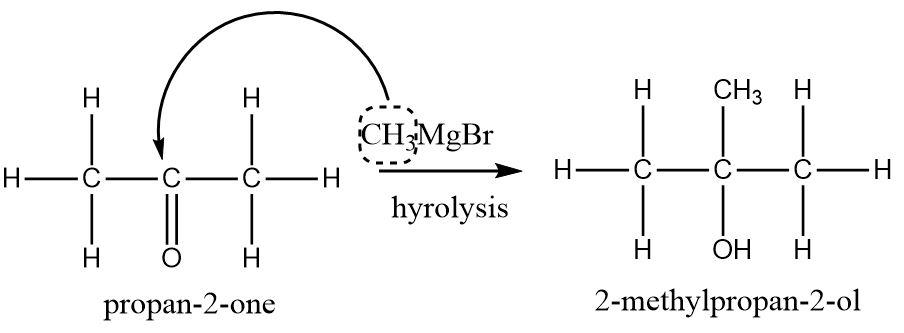
How will you prepare
Answer
416.4k+ views
Hint: The synthesis of an organic product can be done only by keeping its structure in mind. The IUPAC name of the desired product
Complete answer:
The organic compound
The reagent given to us is methyl magnesium bromide which is known as the Grignard’s reagent. This is a special organometallic compound containing magnesium metal bonded to a halogen (bromine in this case) and an alkyl group (methyl in this case). Due to the electronegativity differences, the molecule is polarized and the carbon atom of the alkyl group gets a partial negative charge and the magnesium metal gets a partial positive charge.
The negatively polarized alkyl group becomes a good nucleophile that is capable of reacting with highly electrophilic functional group like the carbonyl compounds. Hence, a reaction between an aldehyde or ketone with a Grignard reagent can be used to synthesize corresponding alcohols with the same number of carbon atoms as the parent carbonyl compound.
The carbonyl compound is selected on the basis of the type of alcohol desired. Since our desired product is

Hence,
Note:
The methyl magnesium bromide must be used along with dry ether in the reaction. The Grignard’s reagent is a very reactive organometallic compound that can react with even traces of water to produce an alkane corresponding to the alkyl present in the reagent.
Complete answer:
The organic compound
The reagent given to us is methyl magnesium bromide which is known as the Grignard’s reagent. This is a special organometallic compound containing magnesium metal bonded to a halogen (bromine in this case) and an alkyl group (methyl in this case). Due to the electronegativity differences, the molecule is polarized and the carbon atom of the alkyl group gets a partial negative charge and the magnesium metal gets a partial positive charge.
The negatively polarized alkyl group becomes a good nucleophile that is capable of reacting with highly electrophilic functional group like the carbonyl compounds. Hence, a reaction between an aldehyde or ketone with a Grignard reagent can be used to synthesize corresponding alcohols with the same number of carbon atoms as the parent carbonyl compound.
The carbonyl compound is selected on the basis of the type of alcohol desired. Since our desired product is

Hence,
Note:
The methyl magnesium bromide must be used along with dry ether in the reaction. The Grignard’s reagent is a very reactive organometallic compound that can react with even traces of water to produce an alkane corresponding to the alkyl present in the reagent.
Latest Vedantu courses for you
Grade 11 Science PCM | CBSE | SCHOOL | English
CBSE (2025-26)
School Full course for CBSE students
₹41,848 per year
Recently Updated Pages
Master Class 10 Science: Engaging Questions & Answers for Success

Master Class 10 Social Science: Engaging Questions & Answers for Success

Master Class 10 Maths: Engaging Questions & Answers for Success

Master Class 10 English: Engaging Questions & Answers for Success

Class 10 Question and Answer - Your Ultimate Solutions Guide

Master Class 9 General Knowledge: Engaging Questions & Answers for Success

Trending doubts
Give 10 examples of unisexual and bisexual flowers

Draw a labelled sketch of the human eye class 12 physics CBSE

Differentiate between homogeneous and heterogeneous class 12 chemistry CBSE

Differentiate between insitu conservation and exsitu class 12 biology CBSE

What are the major means of transport Explain each class 12 social science CBSE

What is the difference between resemblance and sem class 12 social science CBSE




